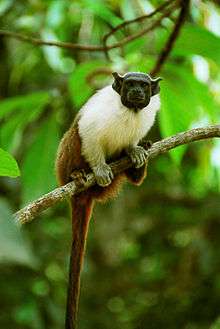Pied tamarin
The pied tamarin (Saguinus bicolor) is a critically endangered primate species found in a restricted area in the Brazilian Amazon Rainforest.
| Pied tamarin[1][2] | |
|---|---|
 | |
| Scientific classification | |
| Kingdom: | Animalia |
| Phylum: | Chordata |
| Class: | Mammalia |
| Order: | Primates |
| Suborder: | Haplorhini |
| Infraorder: | Simiiformes |
| Family: | Callitrichidae |
| Genus: | Saguinus |
| Species: | S. bicolor |
| Binomial name | |
| Saguinus bicolor (Spix, 1823) | |
 | |
| Geographic distribution | |
Range
This New World monkey is found within and just north of the city limits of Manaus, the capital of the Amazonas state of Brazil. The main distribution is in the rio Cuieiras and rio Preto da Eva interfluvium. Pied tamarins are also found in the adjacent rio Preto da Eva and rio Urubu interfluvium, but are comparatively rare.[4] There appears to be interspecific competition between the pied tamarin and the red-handed tamarin[4] with the red-handed tamarin gradually displacing the pied tamarin from areas of its historical distribution.[5] There are therefore multiple threats to the long-term survival of the pied tamarin that stem from habitat destruction and from interspecific competition.
Description
The pied tamarin's body measures 20.8–28.3 cm.; including the tail it measures 33.5–42.0 cm. Males weigh 428 grams (n = 4).[6] Its life expectancy is approximately 10 years in the wild.
Behavior and reproduction
Individuals live in groups of 2 to 15 members with little intra-group competition. Average group size in the Reserva Florestal Adolpho Ducke is 4.8 individuals per group (n = 41),[7] and other areas around Manaus reported mean group sizes of 6.19 ± 2.62 (n = 46).[8]
Only the alpha female of the group will breed. Reproduction in other females of the group is behaviorally suppressed. The gestation lasts 140–170 days and mothers typically give birth to twins. Young tamarins are cared for primarily by the father and turned over to the mother only to nurse; however, the entire group helps with the care of the young.
Tamarins are omnivorous, their diet consisting of fruit, flowers, nectar, insects, spiders, small vertebrates and bird eggs.[4] Its natural predators are small cats, birds of prey, and snakes. In urban setting main predators are domestic and feral cats and dogs. Because of the destruction of its natural habitat, the species is at risk. However, the species also occurs in several protected areas.
Conservation
Major protected areas outside Manaus include:
- The Rio Negro State Park South Section
- The Sauim-Castanheiras Wildlife Refuge (97 ha)
- The Adolfo Ducke Forest Reserve of the Instituto Nacional de Pesquisas da Amazônia (INPA) (10,000 ha)
- The Walter Egler Forest Reserve of the Instituto Nacional de Pesquisas da Amazônia (INPA) (630 ha)
- The Military training area of the Centro de Instrução de Guerra na Selva (CIGS) (115,000 ha)
- The Tupé Sustainable Development Reserve
- The Rio Negro Left Bank Environmental Protection Area – Tarumã-Açú/Tarumã-mirim Sector
Major protected areas within Manaus include:
- The campus of Universidade Federal do Amazonas (UFAM) (670 ha)
- The buffer zone around the Eduardo Gomes international airport (800 ha)
- The buffer zone around the Ponte Pelada regional airport (57.6 ha)
- The Sumaúma State Park (51 ha)
- The Mindu Municipal Park (26.5 ha)
- The worker's country club SESCI (49.5 ha)
- The worker's country club SESI (100 ha)
- The 1ºBIS/CIGS military zoo and surrounding areas
References
| Wikispecies has information related to Pied Tamarin |
| Wikimedia Commons has media related to Saguinus bicolor. |
- Groves, C.P. (2005). Wilson, D.E.; Reeder, D.M. (eds.). Mammal Species of the World: A Taxonomic and Geographic Reference (3rd ed.). Baltimore: Johns Hopkins University Press. p. 133–134. ISBN 0-801-88221-4. OCLC 62265494.
- Rylands AB, Mittermeier RA (2009). "The Diversity of the New World Primates (Platyrrhini)". In Garber PA, Estrada A, Bicca-Marques JC, Heymann EW, Strier KB (eds.). South American Primates: Comparative Perspectives in the Study of Behavior, Ecology, and Conservation. Springer. pp. 23–54. ISBN 978-0-387-78704-6.
- Gordo, M., Jerusalinsky, L., Mittermeier, R.A., Rohe, F., Boubli, J., Subirá, R. & Vidal, M. (2019). "Saguinus bicolor". The IUCN Red List of Threatened Species. IUCN. 2019: e.T40644A17931870.CS1 maint: multiple names: authors list (link)
- Röhe, F. (2006). Área de contato entre as distribuições geográficas de Saguinus midas e Saguinus bicolor (Callitrichidae-Primates): a importância de interações e fatores ecológicos. Dissertação de Mestrado — INPA/UFAM. p. 71.
- Ayres, J. M.; R. A. Mittermeier & I. D. Constable (1982). "Brazilian Tamarins on the way to extinction?". Orix. 16 (04): 329–333. doi:10.1017/S0030605300017786.
- Smith, R. J. & W. L. Jungers (1997). "Body mass in comparative primatology". Journal of Human Evolution. 32 (6): 523–559. doi:10.1006/jhev.1996.0122. PMID 9210017.
- Vidal, M. D. & R. Cintra (2006). "Effects of forest structure components on the occurrence, group size and density of groups of bare-face tamarin (Saguinus bicolor – Primates: Callitrichinae) in Central Amazonia". Acta Amazonica. 36: 237–248. doi:10.1590/s0044-59672006000200014.
- Subirá, R. J. (1998). Avaliação da situação atual das populações selvagens do Sauim-de-coleira Saguinus b. bicolor (Spix, 1823). Dissertação de Mestrado — UNB. p. 98.
